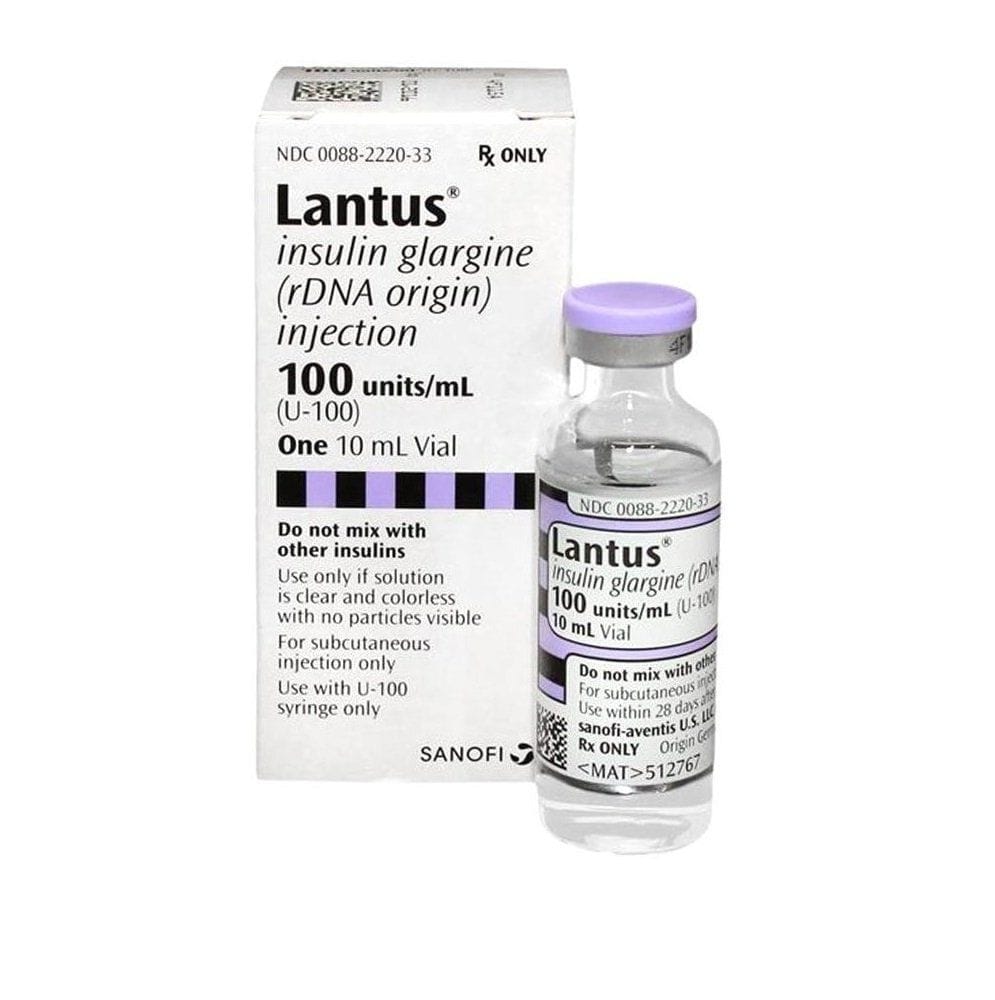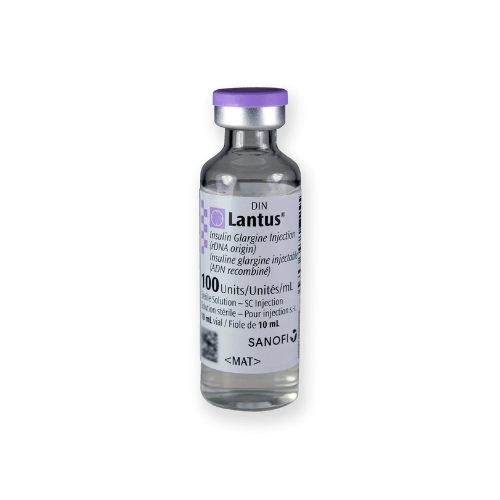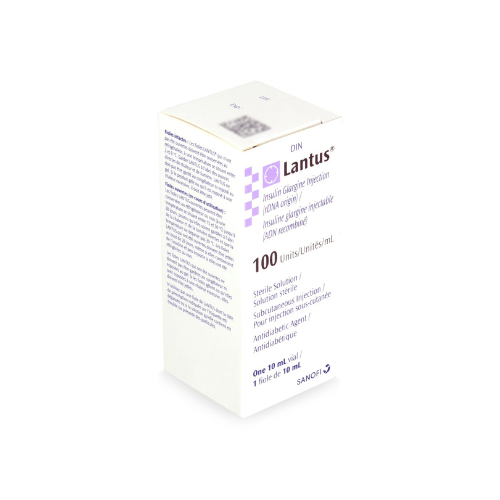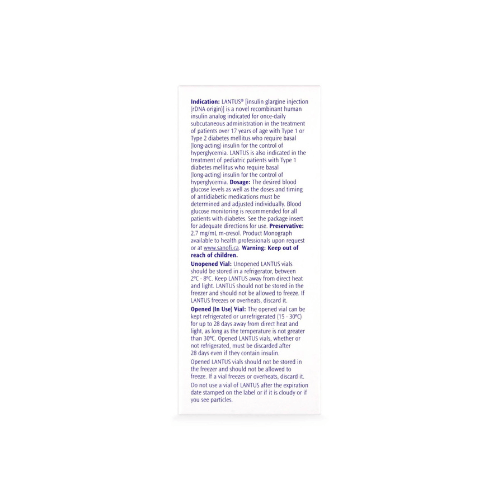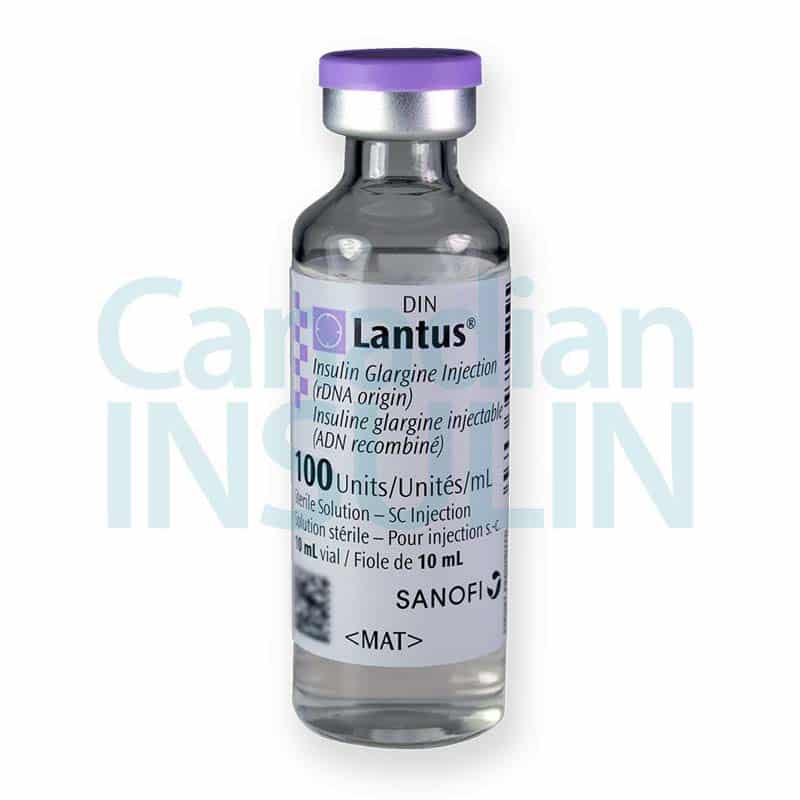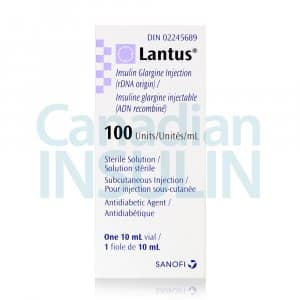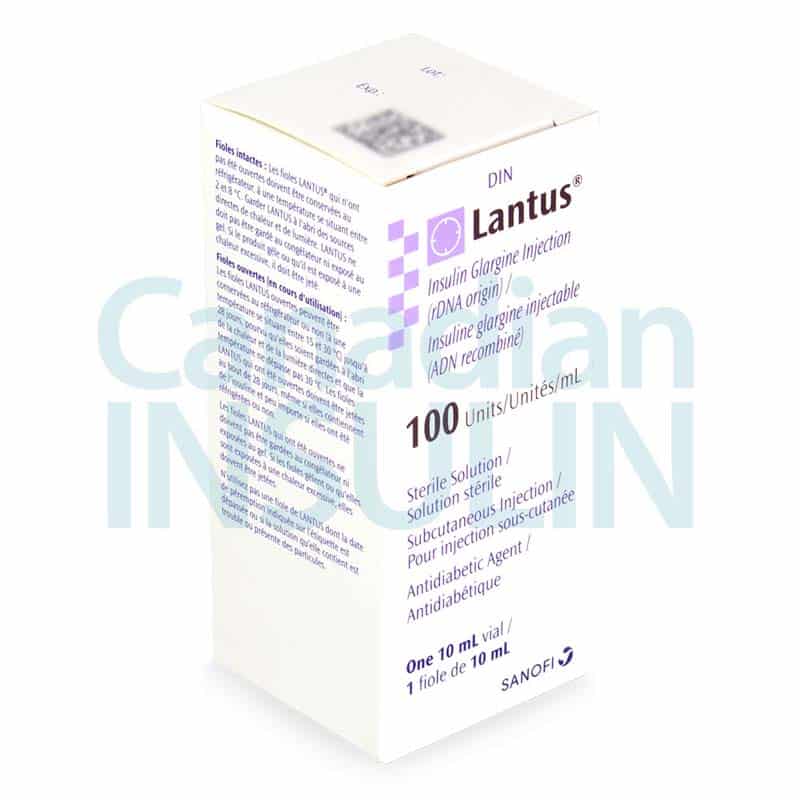Please note: a valid prescription is required for all prescription medication.
What Lantus® Is and How It Works
Lantus® is insulin glargine U-100, a long-acting basal insulin. It helps control fasting and between-meal blood glucose in adults and children. This page explains key facts and safe use, with US delivery from Canada. Many patients pay cash without insurance and look for predictable costs.
CanadianInsulin is a prescription referral service. We verify your prescription with your clinic, and licensed Canadian pharmacies dispense your order.
Lantus works slowly and steadily for about 24 hours in most people. It does not have a pronounced peak. It supplies a baseline of insulin so your body can manage glucose between meals and overnight. You still need rapid-acting insulin at meals if your clinician prescribes it for type 1 diabetes. Some people with type 2 diabetes use Lantus alone or with other medicines.
Learn more about vial use and steady control in our guide Lantus Vial.
Who Lantus® Is For
Lantus is indicated for adults with type 1 or type 2 diabetes. It is also approved for pediatric patients with type 1 diabetes. It provides basal insulin coverage as part of a broader plan.
Lantus is not for diabetic ketoacidosis treatment. It is not for use in an insulin pump or for intravenous injection. People with a history of severe hypoglycemia or insulin allergy should discuss risks before starting. If you have type 2 diabetes and need basal insulin, your clinician may consider Lantus as one option. You can also review our condition overview for Type 2 Diabetes.
Dosage and Usage
Use Lantus exactly as prescribed. Inject subcutaneously once daily at the same time each day. Rotate injection sites within the same region to reduce skin changes.
- Type 1 diabetes: Lantus is part of a total daily insulin plan. Basal insulin is commonly one-third to one-half of the total daily dose. Clinicians individualize dosing based on weight, insulin sensitivity, and glucose patterns.
- Type 2 diabetes: Many adults start at 10 units once daily or about 0.2 units per kilogram once daily. Clinicians adjust the dose based on fasting glucose goals.
Your clinician may adjust the dose every few days based on self-monitoring. Do not change your dose without guidance. If switching from another basal insulin, your clinician will provide a plan to reduce hypoglycemia risk. Do not mix Lantus with other insulins. Inject only into subcutaneous tissue of the abdomen, thigh, or upper arm.
Strengths and Forms
Lantus vials are U-100 (100 units per mL). The common vial is 10 mL, for a total of 1000 units. The same insulin glargine is also available in other presentations for convenience. If you prefer a prefilled device, consider Lantus® Solostar Pens. If you use a reusable pen, you can ask about Lantus® Cartridges.
Availability may vary by pharmacy and lot. All presentations contain insulin glargine U-100. Vials require U-100 syringes. Cartridges and pens use compatible pen needles.
For other long-acting vial options, you can browse our category for Long Acting Insulin Vials.
Missed Dose and Timing
If you miss a dose, take it as soon as you remember the same day. Then return to your usual schedule. If it is close to your next dose, follow your clinician’s advice and monitor glucose. Do not double a dose to catch up. Keep a record of doses and fasting readings. Ask your clinic how to handle long delays or travel-related timing changes.
Storage and Travel Basics
Unopened vials should be refrigerated as directed on the label. Do not freeze. Keep away from heat and direct light. Once in use, a Lantus vial can typically be kept at room temperature for up to 28 days. Discard after the in-use period even if insulin remains. Do not use if the solution is cloudy, colored, or contains particles.
For travel, keep vials in the original box with your prescription label. Use insulated packs to protect from temperature extremes. Do not place insulin directly next to ice packs. Carry a backup syringe supply and glucose sources for lows. Our shipments maintain cold-chain handling to protect product quality in transit.
Pen Handling and Sharps Disposal
When using vials, draw your dose with a new U-100 insulin syringe each time. Clean the vial top with alcohol. Insert air equal to your dose, then draw insulin slowly to avoid bubbles. Inject into subcutaneous tissue as instructed by your clinician.
Dispose of used syringes and needles in an approved sharps container. Follow your local rules for disposal or take-back programs. Never share needles, syringes, or vials.
Benefits
- Once-daily basal insulin coverage for most patients.
- Flat, predictable action profile without a strong peak.
- Supports fasting glucose control when used as prescribed.
- Compatible with mealtime insulin plans for type 1 diabetes.
- Multiple presentations to fit different dosing preferences.
Side Effects and Safety
- Low blood sugar (shakiness, sweating, confusion, fast heartbeat).
- Injection site reactions such as redness or swelling.
- Weight gain, mainly with improved glycemic control.
- Swelling in hands or feet.
- Skin thickening or pits at injection sites.
Serious risks include severe hypoglycemia and severe allergic reactions. Hypokalemia can occur with insulin use. Fluid retention and heart failure can worsen when insulin is used with thiazolidinediones. Seek medical help for severe or persistent symptoms. Keep glucagon or a rapid glucose source available if recommended by your clinician.
Drug Interactions and Cautions
Many medicines may increase or decrease insulin needs. Examples include corticosteroids, thiazide diuretics, beta-blockers, ACE inhibitors, GLP-1 agonists, and SGLT2 inhibitors. Alcohol may increase hypoglycemia risk. Beta-blockers can mask low blood sugar symptoms. Tell your clinician about every prescription, nonprescription, and supplement you take. Do not mix Lantus with any other insulin or dilute it. Use only subcutaneously. Monitor more often during illness, travel, or medication changes.
What to Expect Over Time
Fasting readings usually improve over days to weeks as your dose is adjusted. Your clinician may guide slow, steady titration to reach goals safely. Many people continue on once-daily dosing. Some may require schedule changes based on patterns. Ongoing monitoring, diet, and activity remain important. You may add or adjust mealtime insulin or other diabetes drugs as your plan evolves.
Compare With Alternatives
Several long-acting insulins offer similar basal coverage. Insulin glargine biosimilar products can help reduce cost. You can review Buy Basaglar Online as an alternative insulin glargine U-100. Another option is insulin degludec, which lasts longer and may allow flexible timing; see Tresiba® Flextouch Pens. Insulin detemir is another basal insulin option that some clinicians use. Your choice depends on history, goals, and insurance or cash-pay preferences.
Pricing and Access
We offer Canadian pricing with US delivery. Many customers compare the cost of a vial online to manage monthly budgets. To explore multi-pack value, check our Bulk Savings page. Interested in current price and availability for this insulin vial? View the product details on this page and proceed to secure checkout.
You can order online, upload your prescription, and our team will confirm it with your clinic. This process helps patients who pay without insurance and those with high deductibles. For seasonal deals, also explore our diabetes promotions category when available.
Availability and Substitutions
Supply can vary. If a specific size is temporarily unavailable, your prescriber may recommend an appropriate alternative or presentation. Some patients move from vials to a pen for convenience. If your clinician suggests a higher-strength glargine for fewer units per injection, you can review Toujeo® Doublestar Prefilled Pen. Do not substitute insulins on your own. Any switch requires medical guidance and a new prescription check.
Patient Suitability and Cost Saving Tips
Lantus may suit adults or children who need consistent basal insulin. It can be paired with rapid-acting insulin for mealtime control. People with frequent nighttime lows, recurrent severe hypoglycemia, or insulin allergy need extra caution and close supervision. Those with heart failure on thiazolidinediones should review risks with their clinician.
- Ask about multi-month supplies to reduce per-vial costs.
- Set refill reminders so you do not run out unexpectedly.
- Keep consistent injection timing to support stable control.
- Rotate sites to protect skin and absorption.
- Review technique yearly to avoid dosing errors.
Questions to Ask Your Clinician
- What starting dose and titration plan fits my goals?
- Should I use Lantus once daily or on a different schedule?
- What are my target fasting and pre-meal glucose ranges?
- How should I handle missed doses or travel across time zones?
- Which mealtime insulin pairs best with my basal plan?
- What signs of hypoglycemia should I watch for and treat?
- When should I consider switching to a pen or another basal insulin?
Authoritative Sources
- FDA DailyMed: Lantus (insulin glargine) Label
- Sanofi: Lantus Product Information
- Health Canada Drug Product Database
Ready to start? Place your order for US delivery from Canada today. This information is educational and does not replace your clinician’s advice or the official label.
Express Shipping - from $25.00
Shipping with this method takes 3-5 days
Prices:
- Dry-Packed Products $25.00
- Cold-Packed Products $35.00
Standard Shipping - $15.00
Shipping with this method takes 5-10 days
Prices:
- Dry-Packed Products $15.00
- Not available for Cold-Packed products
Can Lantus be taken twice daily?
Most people use Lantus once daily. Some require split dosing based on clinical judgment. Follow your clinician’s schedule and the official label.
Can I mix Lantus with other insulin in the syringe?
No. Do not mix or dilute Lantus. Mixing changes its action and may cause unpredictable glucose control.
How long does an opened Lantus vial last?
Once in use, most Lantus vials are good for up to 28 days at room temperature. Discard after that period, even if insulin remains.
What syringes should I use with Lantus vials?
Use U-100 insulin syringes sized for your dose. Never reuse or share syringes. Dispose of sharps safely.
Is Lantus safe for children?
Lantus is indicated for pediatric patients with type 1 diabetes. Dosing and monitoring are individualized by the child’s clinician.
Can I use Lantus in an insulin pump?
No. Lantus is not approved for pump or intravenous use. It is for subcutaneous injection only.
What if I switch from another basal insulin to Lantus?
Switching requires a plan from your clinician. They will adjust timing and dose, then monitor glucose to reduce hypoglycemia risk.
Rewards Program
Earn points on birthdays, product orders, reviews, friend referrals, and more! Enjoy your medication at unparalleled discounts while reaping rewards for every step you take with us.
You can read more about rewards here.
POINT VALUE
How to earn points
- 1Create an account and start earning.
- 2Earn points every time you shop or perform certain actions.
- 3Redeem points for exclusive discounts.
You Might Also Like
Related Articles
National Diabetes Education Week: Tools for Better Care
Every November, millions of people come together to raise awareness about diabetes, a condition that affects more than 38 million Americans. Among the month-long initiatives, National Diabetes Education Week stands…
Diabetic Eye Disease Month: Protect Your Vision Today
Vision is one of our most precious senses, yet millions of people with diabetes are at risk of losing it without even realizing it. According to the Centers for Disease…
Join the Cause: American Diabetes Month 2025
Every November, millions of Americans come together to shine a light on one of the country’s most pressing health challenges — diabetes. American Diabetes Month is more than just a…
Orforglipron vs Rybelsus: Which Is More Effective?
According to the International Diabetes Federation (IDF), around 589 million adults aged 20–79 are living with diabetes globally. This marks the need for immediate medical action and treatment. Fortunately, with…

